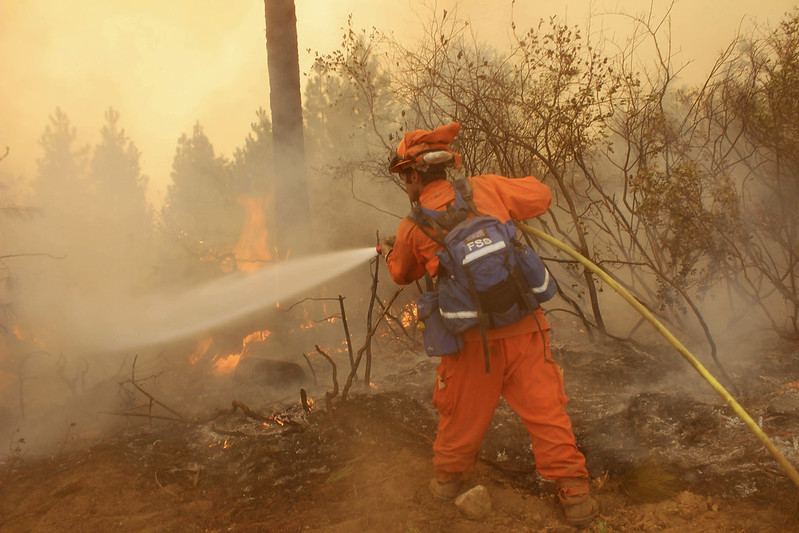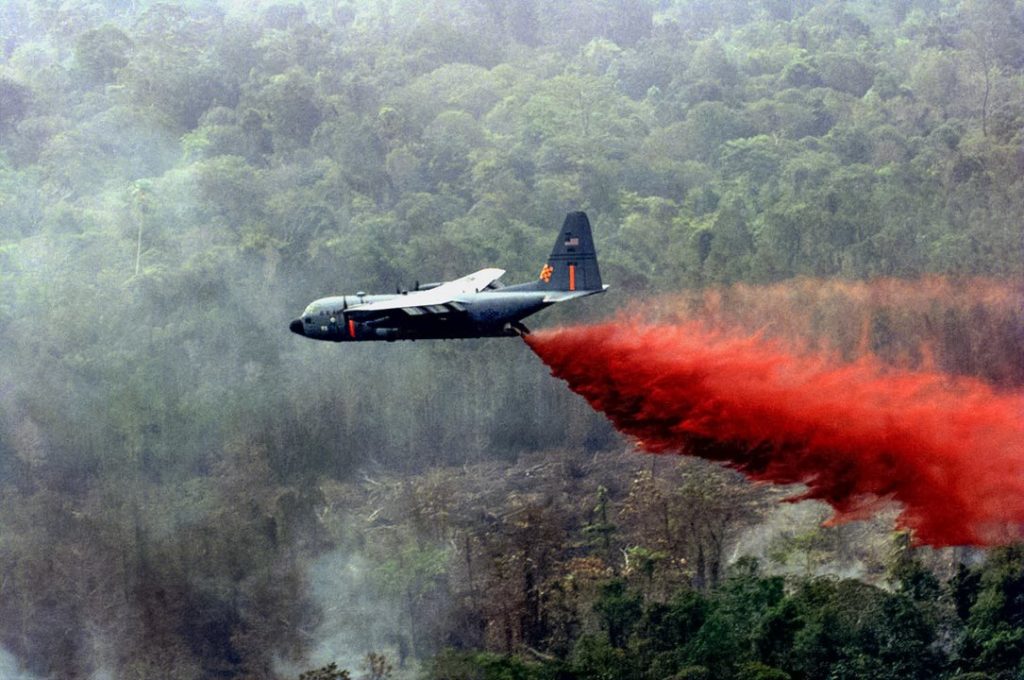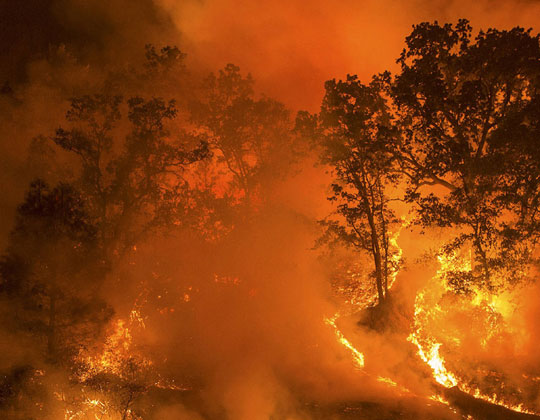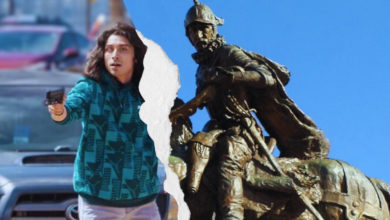The effects of capitalist-driven climate change have become a major and destructive force in the western United States, which is experiencing its worst drought in 1,200 years. As a result, devastating fires have swept across the region. This spring, these developments hit the state of New Mexico especially hard.
Several significant and destructive fires broke out across the state — all of which caused major damage to communities and to the livelihoods of residents. Two fires — Black Fire and the Calf Canyon/Hermit Peaks Fire — have proven far more devastating than any fires in New Mexico history.
These two fires, the largest in the state’s history, have reached approximately 340,000 plus acres of devastated land. Of the two, the Black Fire has been generally limited to uninhabited land. For many reasons the combined Calf Canyon/Hermit Peaks Fire has been much more destructive. The footprint of the Calf Canyon/Hermit Peaks fire is 45 miles long north to south, and 20 miles east to west. The fire has destroyed more than 900 structures, displaced tens of thousands of residents and cost hundreds of millions of dollars of damage.

Why do out-of-control wildfires wrack the West?
In addition to climate change, responsibility for this fire must be assigned to centuries of irresponsible capitalist land management.
The two massive wildfires in New Mexico were started by the United States Forest Service during prescribed burns. Prescribed burning has been a practice of land husbandry for centuries, first undertaken by Indigenous people who recognized the benefits of seasonal burning to replenish the land with nutrients, to allow new growth, and to bring in different species of plants and animals.
However, prescribed burning is not as straightforward today for two main reasons. One reason is climate change-fueled drought, hotter summers and less precipitation. The second reason is that the West has seen almost two centuries of profit-driven land development and short-sighted fire suppression practices that have made millions for banks and real estate developers while contributing to the unprecedented fires we see today. What is really to blame for the Black Fire and the Calf Canyon/Hermit Peaks fire is climate change and the irresponsible land development techniques used by capitalists that have turned the western United States into a powder keg.
In order to combust, a fire needs three things: heat, oxygen and fuel. Fire scientists classify fires based on fuels; they do this because understanding fuel is essential to stopping or “suppressing” an out-of-control fire. Wildfires, or wildland fires, use naturally occurring “combustible material” fuels — as opposed to gasses or liquids — like trees, brush or grass. However, human-caused climate change has affected and changed these “natural” fuels, causing them to become drier and more receptive to igniting and carrying fire. In addition, centuries of capitalist land development has demanded that natural wildfires be suppressed, and this has increased the density and amount of fuel in many areas.
In the Americas, Native peoples used fire to develop the land for thousands of years before the European invasion. The type of development championed by settlers differed greatly from the small-scale farming of Native Americans. As early capitalists, the settlers wanted to produce large profits by quickly growing cash crops, and they needed to suppress fires to get the most out of the land.
Wildfire management under capitalism focuses on constantly holding back fire so that land can be developed without pause and capitalists can continue to rake in profits. This is especially evident in the U.S. West, where wildfire has historically threatened and inhibited capitalist land development. For many years, settlers in the West could only dream of suppressing fire, but with the population increasing rapidly during the Westward Expansion, this dream became a reality. Free-burning wildland fire was virtually eliminated during the 18th and 19th centuries through suppression efforts by the U.S. government and private land developers. But it was not stopped forever, it was just held back until it exploded into the conflagrations we see today.
Does the U.S. Forest Service help to prevent wildland fire?
Each year, the USFS receives more and more money to fight fires. In 2017, the USFS received $4.9 billion. In 2021, that number jumped to $7.4 billion. In some states in the West, the Forest Service receives military equipment like massive planes and helicopters to fight fires. In other states, prisoners are enlisted alongside USFS firefighters to fight wildland fire.

But the USFS still struggles to keep up with the number of fires in the West. Sadly, the current New Mexico fires are not the first time the USFS was responsible for a major fire in New Mexico. In 2000, the USFS started the Cerro Grande Fire, which destroyed 300 homes in Los Alamos and directly threatened the Los Alamos National Laboratory. The current fires are much larger than this.
In a report published by USFS, Chief Randy Moore admits to underestimating the effects of climate change: “Climate change is leading to conditions on the ground we have never encoutered.” Moore rightfully says that prescribed burning is a useful tactic to prevent wildland fire. However, the unpredictability of the weather, caused by climate change, means that even a carefully planned burn can explode into a conflagration.
In addition, local communities in New Mexico say that the Forest Service has played a central role in the mismanagement of the land. Prescribed burns rarely take place with the consent or collaboration of local communities, and in New Mexico, some of these communities have worked this land for centuries.
The USFS instituted rules in advance of the fires that barred local communities in the area from collecting their own firewood, which left a massive collection of fuel in the Santa Fe National Forest. Mora, New Mexico native Antonia Roybal Mack’s family lost hundreds of acres to the fire and expressed her frustration with USFS mismanagement: “The prescribed burn was the match, but the fuel was there for decades when they wouldn’t let people into the forest to collect vigas or firewood.”
According to San Miguel County Commissioner and water activist Janice Varlea, the forest belongs to the Indigenous and Latino caretakers who have been collectively managing the forests for centuries: “We locals, we feel like, hell yes, it’s our forest. Yeah, we let the Forest Service manage it, and we let everybody in the world come here, but it’s our forest. We have ownership from our proximity to it, from our history and cultural connection to it, from our heart.”
People in several New Mexico towns must now return to destroyed homes and complete loss of family possessions. They must also be prepared to deal with flooding from the burn scars created by the fires.
Promises from New Mexico Governor Michelle Lujan Grisham and President Biden to pay for all of the damages and compensate those affected have not yet materialized. Such promises can never compensate for the loss of personal items and buildings.
What is the solution to massive wildfires in the West?
Decades of mismanagement mean that wildfires cannot be immediately ceased in the West. It is essential that there are plans in place for increased fires, and when fires destroy the land and people’s homes, the government can help to rebuild instead of private insurance companies. Private insurance companies are notorious for refusing to pay the price to rebuild, and they chronically underinsure people, making sure that they get a payment every month, but not paying out when disaster comes.

Turning back so much mismanagement of the land and environment can only take place under a clear plan, and this is impossible under capitalism, where profit is always the decider of the “plan” for development. Profit-driven land management must end and be replaced with a clear plan for land development and husbandry of the environment. This plan must be informed by the practices of the Indigenous people of the West, who carefully developed ecosystems through the years before colonization. This type of plan is only possible under socialism.
While few socialist societies have confronted massive wildfires like those in the Western U.S., we can look to a country like Cuba to see how it plans for and responds to natural disasters in general. Before Hurricane Irma, the Cuban government effectively evacuated people and prepared infrastructure, and in the aftermath, the people effectively rebuilt while the state sent doctors and aid to other affected lands in the Caribbean. Meanwhile, unprepared oil refineries in Houston were severely damaged during Hurricane Harvey and leached a chemical cocktail of pollutants into local water and air. For months after the hurricane, parts of Puerto Rico were without power.
While capitalist states align themselves first with the interests of private capitalists and ignore disasters until they cut into profits, socialist societies prioritize the interests of the masses of working people before private profits. They prepare for disasters while simultaneously working to develop industry responsibly for the benefit of all people. Climate change and years of irresponsible capitalist land development have fueled more dangerous and destructive natural disasters, but it is not the disasters themselves that are unnatural. What is unnatural, and what needs to be replaced, is the system of capitalism.





